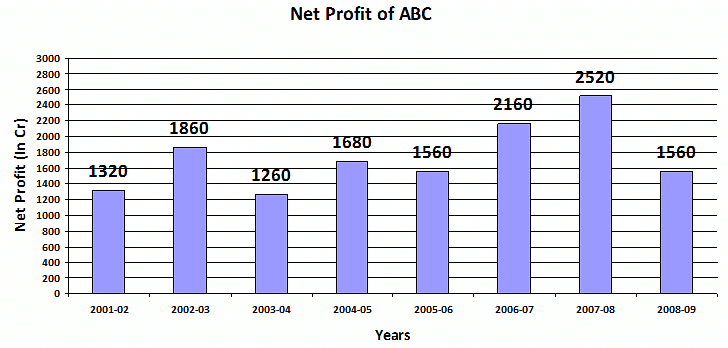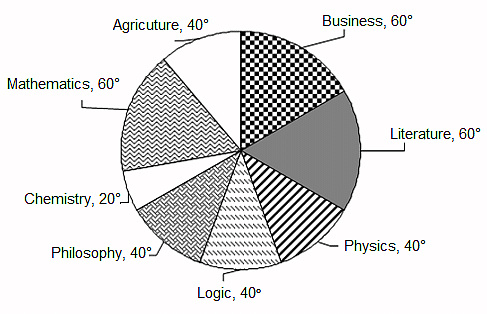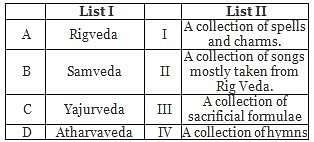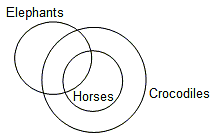TS SET Paper 1 Mock Test - 2 - TS TET MCQ
30 Questions MCQ Test TS SET Mock Test Series 2024 - TS SET Paper 1 Mock Test - 2
______ is committing to the factual information to memory.
Direction: Study the following table and answer the question asked.
The data of total number of people in different cities of a country and percentage of females is given in the table.

Q. The total number of people in City D is approximately what percent of the total number of people in City B?
The data of total number of people in different cities of a country and percentage of females is given in the table.

| 1 Crore+ students have signed up on EduRev. Have you? Download the App |
Direction: Choose the correct option with the help of Assertion (A) and Reason (R).
Assertion (A): The initial messages to students in the classroom by a teacher need not be critical to establishing interactions later.
Reason (R): More control over the communication process means more control over what the students are learning.
Assertion (A): The initial messages to students in the classroom by a teacher need not be critical to establishing interactions later.
Reason (R): More control over the communication process means more control over what the students are learning.
Directions: In the following question, there are two statements followed by two conclusions I and II. You are to take the two statements to be true even if they seem to be at variance from the commonly known facts and then decide which of the conclusions logically follow(s) from the two statements.
Statements:
Some elephants are horses.
All horses are crocodiles.
Conclusions:
I. No crocodile is an elephant.
II. Some elephants are crocodiles.
Directions: Read the data given in the following bar-graph carefully and answer the following question.
The bar-graph shows the net profit of a multinational company ABC (in Cr) from 2001-2002 to 2008-2009.

Q. What is the ratio of the number of years having more net profit than the average profit to the number of years having lesser net profit than the average profit of the company?
The MHRD, Government of India, initiative "e-ShodhSindhu" provides students and researchers access to
Under the Air Quality Index in India, which of the following pollutants is not included?
Directions: Read the following passage carefully and answer the given question.
James adison said, "People who mean to be their own governors must arm themselves with power that knowledge gives." In India, the Official Secrets Act, 1923 was a convenient smokescreen to deny members of the public access to information. Public functioning has traditionally been shrouded in secrecy. But in a democracy in which people govern themselves, it is necessary to have more openness. In the maturing of our democracy, right to information is a major step forward; it enables citizens to participate fully in the decision-making process that affects their lives so profoundly. It is in this context that the address of the Prime Minister in the Lok Sabha is significant. He said, "I would only like to see that everyone, particularly our civil servants, should see the Bill in a positive spirit; not as a draconian law for paralysing Government, but as an instrument for improving Government-Citizen interface resulting in a friendly, caring and effective Government functioning for the good of our People." He further said, "This is an innovative Bill, where there will be scope to review its functioning as we gain experience. Therefore, this is a piece of legislation, whose working will be kept under constant reviews."
The Commission, in its Report, has dealt with the application of the Right to Information in Executive, Legislature and Judiciary. The Judiciary could be a pioneer in implementing the Act in letter and spirit because much of the work that the Judiciary does is open to public scrutiny. Government of India has sanctioned an e-governance project in the Judiciary for about Rs. 700 crore which would bring about systematic classification, standardisation and categorisation of records. This would help the Judiciary to fulfil its mandate under the Act. Similar capacity building would be required in all other public authorities. The transformation from non-transparency to transparency and public accountability is the responsibility of all three organs of the State.
Q. The Commission made the Bill effective by
Directions: Read the following passage and answer the given questions:
Recently, India witnessed a severe power shortage due to high demand and the non-availability of adequate coal supply. An energy deficit of more than 100 million units has been recorded during the month of April 2022. Rajasthan, Haryana, Punjab, UP, Bihar, and Madhya Pradesh were the most affected states. India is the second largest country in terms of population, and the usage of electricity is increasing day by day. In today's India, electricity has reached even the remotest areas, and people are reaping its benefits. Electricity is critical to the overall development of society and the country, including technological development. However, technological advances require more electricity. The power requirement of many industries, such as railroads, agriculture, and domestic use, is increasing day by day.
The advancement of technology and the resurgence of economic activity following the COVID-19 disruptions increased the demand for power. In April 2022, the average daily energy requirement increased to 4,512 million units, as opposed to 3,941 million units in April 2021, registering a growth of 14.5%. The use of electricity has increased in many industries, including railways, agriculture, and households. India's thermal power plants are also running well below their capacity, which could have managed this demand increase by increasing thermal generation. To address the problem of the power crisis in India, there is a need to change our planning and policies from ones that mainly manage shortages to ones that are flexible. Policies should be formulated with a focus on long-term structural solutions that address delivery, financial viability, and a robust mechanism for resource planning. The focus should be on ensuring that power plants operate efficiently. To address power shortages, a strategic approach to the low-cost energy transition, such as renewable energy and opportunities for diversification in the energy mix, is critical. For long-term power security, greater attention should be paid to accelerating generation from renewable energy sources.
Q. Choose the most appropriate option that describes the meaning of the term ‘renewable energy’ as used in the passage.
The flexible method in which a teacher can shift from one form of instruction to another in order to maintain the focus of students is known as:
Directions: Read the following passage carefully and answer the question.
The phrase “What is it like?“ stands for a fundamental thought process. How does one go about observing and reporting on things and events that occupy segments of earth space? Of all the infinite variety of phenomena on the face of the earth, how does one decide what phenomena to observe? There is no such thing as a complete description of the earth or any part of it, for every microscopic point on the earth’s surface differs from every other such point. Experience shows that the things observed are already familiar, because they are like phenomena that occur at home or because they resemble the abstract images and models developed in the human mind.
How are abstract images formed? Humans alone among the animals possess language; their words symbolise not only specific things but also mental images of classes of things. People can remember what they have seen or experienced because they attach a word symbol to them.
During the long record of our efforts to gain more and more knowledge about the face of the earth as the human habitat, there has been a continuing interplay between things and events. The direct observation through the senses is described as a percept; the mental image is described as a concept. Percepts are what some people describe as reality, in contrast to mental images, which are theoretical, implying that they are not real.
The relation of Percept to Concept is not as simple as the definition implies. It is now quite clear that people of different cultures or even individuals in the same culture develop different mental images of reality and what they perceive is a reflection of these preconceptions. The direct observation of things and events on the face of the earth is so clearly a function of the mental images of the mind of the observer that the whole idea of reality must be reconsidered.
Concepts determine what the observer perceives, yet concepts are derived from the generalisations of previous percepts. What happens is that the educated observer is taught to accept a set of concepts and then he/she sharpens or changes these concepts during a professional career. In any one field of scholarship, professional opinion at one time determines what concepts and procedures are acceptable, and these form a kind of model of scholarly behaviour.
Q. The relation of Percept to Concept is
Given below are two statements:
Statement I: Buddhism accepts Upamana as an independent source of valid knowledge.
Statement II: In Upamana, knowledge of an object is determined by perception and testimony.
In the light of the above statements choose the correct answer from the options given below:
‘Fly ash’ produced in thermal power plants is an eco-friendly resource for use in:
1) agriculture as micro-nutrient
2) wasteland development
3) dam and water holding structures
4) brick industry
Choose the correct answer from the code given below:
Directions: Read the following passage carefully and answer the question.
The popular view of towns and cities in developing countries and of urbanisation process is that despite the benefits and comforts it brings, the emergence of such cities connotes environmental degradation, generation of slums and squatters, urban poverty, unemployment, crimes, lawlessness, traffic chaos etc. But what is the reality? Given the unprecedented increase in urban population over the last 50 years from 300 million in 1950 to 2 billion in 2000 in developing countries, the wonder really is how well the world has coped, and not how badly.
In general, the urban quality of life has improved in terms of availability of water and sanitation, power, health and education, communication and transport. By way of illustration, a large number of urban residents have been provided with improved water in urban areas in Asia’s largest countries such as China, India, Indonesia and Philippines. Despite that, the access to improved water in terms of percentage of total urban population seems to have declined during the last decade of 20th century, though in absolute numbers, millions of additional urbanites have been provided improved services. These countries have made significant progress in the provision of sanitation services too, together, providing for an additional population of more than 293 million citizens within a decade (1990-2000). These improvements must be viewed against the backdrop of rapidly increasing urban population, fiscal crunch and strained human resources and efficient and quality-oriented public management.
Q. Which of the following is/are not considered the indicator(s) of urban quality of life?
Which part of the Constitution of India is known as "Code of Administrators"?
If you get an opportunity to teach a visually challenged student along with normal students, what type of treatment would you like to give him in the class?
Given below are two statements, one labelled as Assertion (A) and the other as Reason(R). Read and examine the statements carefully and choose the correct option.
Assertion (A): Some carbonaceous aerosols may be carcinogenic.
Reason (R): They may contain polycyclic aromatic hydrocarbons (PAHs).
Direction: Read the given passage and answer the questions that follow.
Early feminist theory had emphasised the commonalities of women's oppression, neglecting profound differences between women in terms of class, age, religion, race and nation. As its exclusionary nature became evident, the collective 'we' of feminism was called into question. The inadequacies of feminist theorising that conflated the condition of white, middle class women with the condition of all women were highlighted in North America by black and Latin feminists, and in Britain by black and Asian feminists. Such critiques evoked the concepts of 'inter‐locking identities' and inter‐locking oppressions'. Related and more radical analyses came from feminist scholars in the Third world, where quite different agendas were called for. These critiques heightened the irrelevance of western feminism's analytical frameworks to the lives of most women around the world and attempted to reposition feminist debate within broader social, economic and cultural contexts of analysis advocated by scholars such as Janus. Such critiques spoke from a post‐colonial position, in which the self‐assumed authority of western feminists to speak about or indeed for others was disputed and decentered. Influential accounts of the tendencies of masculinist imperialist ideological formation to construct a 'monolithic Third world' woman', discursively constituted as the universal victim of Third world patriarchy, challenged feminists to "unlearn" their privilege and to deconstruct their own authority as intellectuals. These positions appeared to question the legitimacy of outside intervention of any kind, whether intellectual or political. Although subsequently attempted by the Third world scholars anxious to move beyond standpoints that threatened to mark all feminist politics as either inauthentic or unnecessary, they were enduringly influential in highlighting the questions identity and authority in feminist studies.
Q. The early feminist theory ignored among women, the issue of:
The communication which happens outside the realm of interpersonal communication is called:
Directions: Answer the given question based on the following data.
Total number of students in the university = 2160

Q. Total number of students of Philosophy and Logic is more than the total number of students of Physics and Chemistry by
Which of the following stages involves the acquisition of knowledge of 'Shrutis' by listening to Vedic Education?
(A) Nididhyasana
(B) logic
(C) Shravan
(D) Contemplation
Which of the following is not true about research ethics?
i. It relates to the accuracy of results
ii. It relates to proving one’s opinion
iii. It relates to using scientific methods
iv. It relates to keeping the anonymity of the respondents
v. It relates to adhering to the propaganda of political parties
Directions: Read the following passage carefully and answer the question.
The Taj Mahal has become one of the world’s best known monuments. This domed white marble structure is situated on a high plinth at the southern end of a four-quartered garden, evoking the gardens of paradise, enclosed within walls measuring 305 metres by 549 metres. Outside the walls, in an area known as Mumtazabad, were living quarters for attendants, markets, sarais and other structures built by local merchants and nobles. The tomb complex and the other imperial structures of Mumtazabad were maintained by the income of thirty villages given specifically for the tomb’s support. The name Taj Mahal is unknown in Mughal chronicles, but it is used by contemporary Europeans in India, suggesting that this was the tomb’s popular name. In contemporary texts, it is generally called simply the Illuminated Tomb (Rauza-i-Munavvara).
Mumtaz Mahal died shortly after delivering her fourteenth child in 1631. The Mughal court was then residing in Burhanpur. Her remains were temporarily buried by the grief-stricken emperor in a spacious garden known as Zainabad on the bank of the river Tapti. Six months later, her body was transported to Agra, where it was interred in land chosen for the mausoleum. This land, situated south of the Mughal city on the bank of the Jamuna, had belonged to the Kachhwaha rajas since the time of Raja Man Singh and was purchased from the then current raja, Jai Singh. Although contemporary chronicles indicate Jai Singh’s willing cooperation in this exchange, extant farmans (imperial commands) indicate that the final price was not settled until almost two years after the mausoleum’s commencement. Jai Singh’s further cooperation was insured by imperial orders issued between 1632 and 1637 demanding that he provide stone masons and carts to transport marble from the mines at Makrana, within his “ancestral domain”, to Agra where both the Taj Mahal and Shah Jahan’s additions to the Agra fort were constructed concurrently.
Work on the mausoleum was commenced early in 1632. Inscriptional evidence indicates much of the tomb was completed by 1636. By 1643, when Shah Jahan most lavishly celebrated the ‘Urs ceremony for Mumtaz Mahal’, the entire complex was virtually complete.
Q. In the contemporary texts, the Taj Mahal is known as
Direction: Following table shows the percentage distribution of votes amongst five candidates A, B, C, D and E and total votes cast (in hundred) during the year 2013 to 2018 of collage presidential election. Study the data carefully and answer the questions based on it.

Q. If, out of the total number of voters in 2016 who fevered D, only 40 % could successfully cast their votes and remaining was unsuccessful. Find the number of voters who appeared to cast their votes in favour of D:
Which of the following statements are true?
1. Some arguments, while not completely valid are almost valid.
2. A sound argument may be invalid.
3. A cogent argument may have a probably false conclusion.
4. A statement may be true or false.
Choose from the alternatives given below.
(A) 1 and 2
(B) 1, 3 and 4
(C) 2 and 4
(D) 3 and 4
Directions: Read the following passage carefully and answer the given question.
The catalytic fact of the twentieth century is uncontrollable development, consumerist society, political materialism, and spiritual devaluation. This inordinate development has led to the transcendental ‘second reality’ of sacred perception that biologically transcendence is a part of human life. As the century closes, it dawns with imperative vigour that the ‘first reality’ of enlightened rationalism and the ‘second reality’ of the beyond have to be harmonised in a worthy state of man. The defacto values describe what we are, they portray the ‘is’ of our ethic, they are est values (Latin est means is). The ideal values tell us what we ought to be, they are esto values (Latin esto ‘ought to be’). Both have to be in the ebb and flow of consciousness. The ever new science and technology and the ever-perennial faith are two modes of one certainty, that is the wholeness of man, his courage to be, his share in Being.
The materialistic foundations of science have crumbled down. Science itself has proved that matter is energy, processes are as valid as facts, and affirmed the non-materiality of the universe. The encounter of the ‘two cultures’, the scientific and the humane, will restore the normal vision, and will be the bedrock of a ‘science of understanding’ in the new century. It will give new meaning to the ancient perception that quantity (measure) and quality (value) coexist at the root of nature. Human endeavours cannot afford to be humanistically irresponsible.
Q. The 'de facto' values in the passage mean
Directions: Read the given passage carefully and answer the following question:
Heritage conservation practices improved worldwide after the International Centre for the Study of the Preservation and Restoration of Cultural Property (ICCROM) was established with UNESCO’s assistance in 1959. The inter-governmental organisation with 126 member states has done a commendable job by training more than 4,000 professionals, providing practice standards, and sharing technical expertise. In this golden jubilee year, as we acknowledge its key role in global conservation, an assessment of international practices would be meaningful to the Indian conservation movement. Consistent investment, rigorous attention, and dedicated research and dissemination are some of the positive lessons to imbibe. Countries such as Italy have demonstrated that prioritising heritage with significant budget provision pays. On the other hand, India, which is no less endowed in terms of cultural capital, has a long way to go. Surveys indicate that in addition to the 6,600 protected monuments, there are over 60,000 equally valuable heritage structures that await attention. Besides the small group in the service of Archaeological Survey of India, there are only about 150 trained conservation professionals. In order to overcome this severe shortage, the emphasis has been on setting up dedicated labs and training institutions. It would make much better sense for conservation to be made part of mainstream research and engineering institutes, as has been done in Europe.
Increasing funding and building institutions are the relatively easy part. The real challenge is to redefine international approaches to address local contexts. Conservation cannot limit itself to enhancing the art-historical value of the heritage structures, which international charters perhaps overemphasise. The effort has to be broad-based: It must also serve as a means to improving the quality of life in the area where the heritage structures are located. The first task, therefore, is to integrate conservation efforts with sound development plans that take care of people living in the heritage vicinity. Unlike in western countries, many traditional building crafts survive in India, and conservation practices offer an avenue to support them. This has been acknowledged by the Indian National Trust for Art and Cultural Heritage charter for conservation but is yet to receive substantial state support. More strength for heritage conservation can be mobilised by aligning it with the green building movement. Heritage structures are essentially eco-friendly and conservation could become a vital part of the sustainable building practices campaign in future.
Q. Which of the following statements best describe(s) the major challenge faced in the implementation of international conservation policies?
Given below are two premises (A and B). Four conclusions are drawn from them. Select the code that states validly drawn conclusion(s) (taking the premises individually or jointly).
Premises:
A. Some dancers are physically fit.
B. Some singers are dancers.
Conclusions:
1. Some singers are physically fit.
2. Some dancers are singers.
3. Some physically fit persons are dancers.
4. Some physically fit persons are singers.
Match List I with List II

Choose the correct answer from the option given below:
|
60 tests
|





 = 120
= 120


















